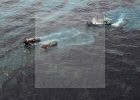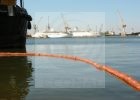General Safety
Oil spill response is an inherently hazardous operation [28]. It involves handling a hazardous material in a marine environment often under less than ideal sea and weather conditions. Deploying, operating, and retrieving heavy and cumbersome oil spill response equipment routinely requires physical exertion and subjects responders to heat and cold stress. Responding to spills in fast-water environments imposes additional hazards due to the extreme loads placed on equipment and the danger of personnel being swept away in the fast currents. A risk assessment should be performed before operations commence.
Table 9.1 summarizes the major hazards, potential injuries, and risk control measures associated with fast-water oil spill response. The water hazards are defined in some detail as these are the single most dangerous hazards associated with fast-water response.
Response Operation and Decision-Making Optimization
The oil spill response process is a dynamic, time sensitive, multifaceted, and complex process suffering from various constraints and challenges. Quantity and properties of the spilled oil, spill locations, environmental and weathering conditions, and the resource status of available response techniques are the factors that affect the consequence of responses (Ornitz & Champ, 2002).
Response operations usually suffer from a limited time window and improper decisions, which may compromise the efficiency of oil recovery and may waste resources. Developing and implementing an optimized strategy becomes highly desirable.
From previous studies, optimization models are being developed to promote decision supporting under changing environmental conditions. You and Leyffer (2011) proposed the mixed-integer dynamic optimization (MIDO) model to simultaneously predict the time trajectories of the oil volume and slick area, the response cleanup schedule, and coastal protection plan, by taking into account the time-dependent oil physiochemical properties, amount spilled, hydrodynamics, weather conditions, facility availability, performance degradation, cleanup operational window, and regulatory constraints. Zhong and You (2011) developed a bi-criterion, multi-period mixed-integer linear programming (MILP) model to simultaneously predict the optimal time trajectories of oil volume and slick area, transportation profile, response resource utilization levels, cleanup schedule, and coastal protection plan. The epsilon-constraint method was used as the optimization method and a Pareto optimal curve was produced to show how optimal total cost and response operations change under different specifications of responsiveness. Weiwei et al. (2015) developed a whole operation scheduling scheme of marine oil spill emergency vessels that followed the characteristics of marine oil spill emergency disposal environment, and the requirements for emergency vessel scheduling, by integrating the ENC, GPS, AIS, wireless network, and oil spill monitoring technologies, to improve the capacity of marine oil spill disposal.
Effective tools for onsite use and training by responders can be developed or created by incorporating these approaches into existing modeling software or new decision systems with user-friendly interfaces.



